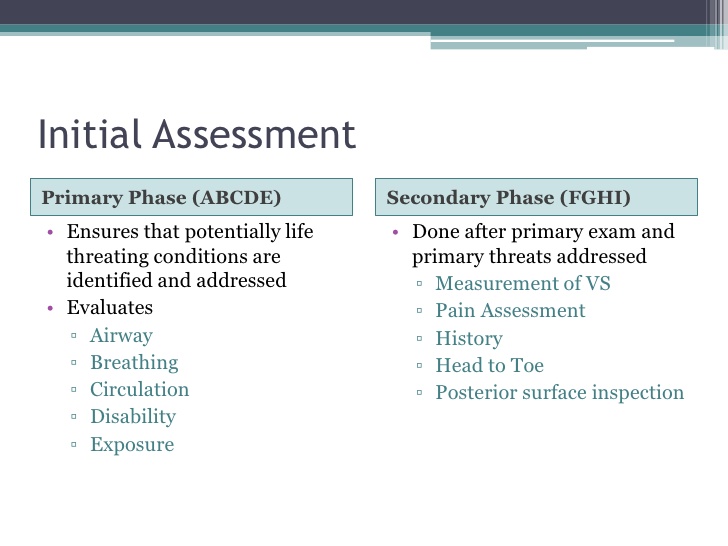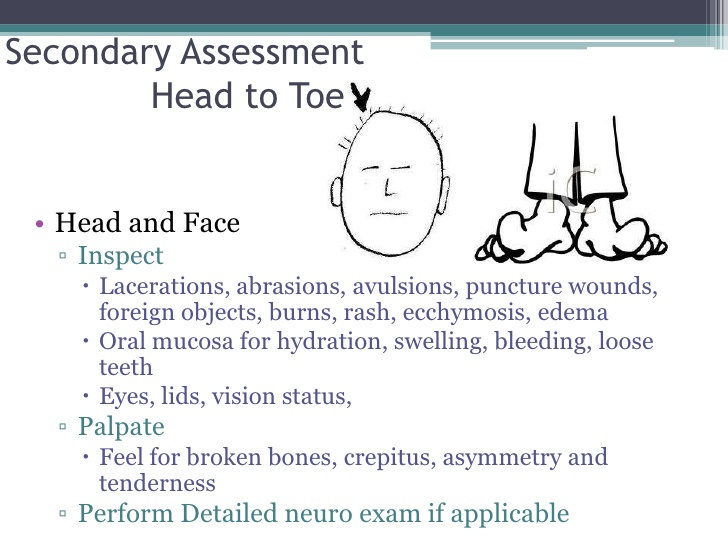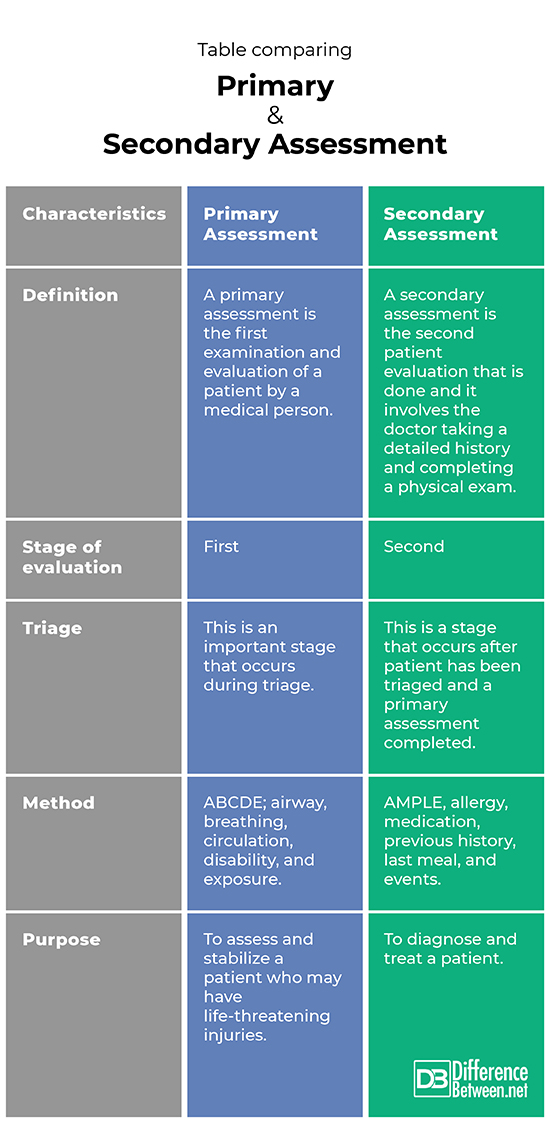Difference Between Primary and Secondary Assessment
A primary assessment is the first stage of patient evaluation that focuses on stabilizing the patient. A secondary assessment is the second stage of patient examination that focuses on diagnosis and treatment.

What is Primary Assessment?
Definition:
A primary assessment is the first examination and evaluation of a patient by a medical person such as a trained emergency medical technician or other first responder to an emergency situation, and is focused on stabilizing the patient.
Method:
The acronym ABCDE is used for individuals to remember the steps of a primary assessment. The acronym stands for: airway, breathing, circulation, disability, and exposure. These steps are crucial in determining how critical a patient is. A patient who is in immediate danger may require quick intervention to save their lives and to stabilize them before continuing on to the next level of care. This may mean the person needs to be intubated and given oxygen or pressure placed on a bleeding wound to stem hemorrhage.
Reasons for assessment:
The purpose of a primary assessment in a healthcare setting or trauma situation is to first determine if the patient has any immediate and life-threatening conditions that should be treated urgently and the patient stabilized. The primary assessment is the first of the assessments done on patients and it gives an idea of how quickly a patient needs to be treated in a triage situation where there are multiple patients needing care.
The professionals that perform the assessment:
In the case of a primary assessment, the person performing the assessment may be an emergency medical technician, paramedic, nurse, or doctor. In the field, an EMT or paramedic is the person who first assesses a patient. At a walk-in clinic there is usually a triage nurse who assesses a patient, while at a doctor’s office the physician may be the first person to evaluate the patient.
Example of a primary assessment for a Covid-19 patient:
Primary assessment of patients when it comes to coronavirus includes a rapid assessment of temperature and respiratory symptoms. Patients may need to be given oxygen if showing low readings on a pulse oximeter.

What is Secondary Assessment?
Definition:
A secondary assessment is the second patient evaluation that is done and it involves the doctor taking a detailed history and completing a physical exam to arrive at a diagnosis and establish a course of treatment.
Method:
The patient is examined thoroughly and asked questions regarding their medical history and any medications they take, as well as any past surgeries, allergies, and medical conditions they have. Vital signs are checked again and tests are ordered and completed, including blood tests and imaging procedures such as X-ray, CT or MRI, as needed. The tests are used to come up with a diagnosis, a necessary step for knowing what treatment options are appropriate. Often the acronym AMPLE is used which stands for: allergy, medication, previous history, last meal, and events. Knowing when the patient last ate is important in case surgery is needed and knowing the events means finding out what could have caused the injury or illness.
Reason for the assessment:
The secondary assessment goes beyond stabilizing the patient; the focus is more on diagnosis and treatment. A secondary assessment can only be performed after a patient has been stabilized and all vital signs are stable.
The professionals that perform the assessment:
In the case of a secondary assessment, the person evaluating the patient is usually a medical doctor. In some doctor’s offices, secondary assessment may be left to a physician’s assistant.
Example of a secondary assessment for a Covid-19 patient:
Once coronavirus is suspected based on a primary assessment, a Covid-19 test needs to be administered and chest X-rays need to be ordered. If the Covid-19 test gives a positive result, the patient is instructed to quarantine at home or is admitted to a hospital where they enter a Covid-19 isolation ward for further treatment.
Difference between Primary and Secondary assessment?
Definition
A primary assessment is the initial, first examination and evaluation of a patient by a medical person where a patient is stabilized. A secondary assessment is the evaluation where a detailed patient history is taken and diagnosis made.
Stage of evaluation
The first stage of evaluation of a patient is the primary assessment. The second stage of evaluation of a patient is the secondary assessment.
Triage
The primary assessment is an important part of triage in emergency settings. The secondary assessment occurs after triage.
Method
Checking the airway, breathing, circulation, disability, and exposure are steps of the primary assessment. Checking allergy, medication, previous history, last meal, and events are steps of the secondary assessment.
Purpose
A primary assessment is completed in order to correctly assess and stabilize a patient who may have life-threatening injuries. A secondary assessment focuses on diagnosing the patient and suggesting a course of treatment.
Table comparing Primary and Secondary assessment

Summary of Primary Vs. Secondary Assessment
- A primary assessment is the first evaluation of a patient that is done to detect life-threatening injuries and stabilize the patient.
- A secondary assessment is done after a primary assessment is completed and focuses on diagnostics and treatment options.
- For Covid-19, a primary assessment focuses on the patient’s respiration and temperature, then in the secondary assessment the patient is tested and treated.
- Difference Between Rumination and Regurgitation - June 13, 2024
- Difference Between Pyelectasis and Hydronephrosis - June 4, 2024
- Difference Between Cellulitis and Erysipelas - June 1, 2024
Search DifferenceBetween.net :
Leave a Response
References :
[0]Olgers, T. J., et al. "The ABCDE primary assessment in the emergency department in medically ill patients: an observational pilot study." Neth J Med 75.3 (2017): 106-11.
[1]Shi, Leiyu, Barbara Starfield, and Jiahong Xu. "Validating the adult primary care assessment tool." Journal of Family Practice 50.2 (2001): 161-161.
[2]Zemaitis, Michael R., et al. "Trauma Secondary Survey." (2017).
[3]Image credit: https://image.slidesharecdn.com/patientassessment-110909004631-phpapp02/95/patient-assessment-21-728.jpg?cb=1315529254
[4]Image credit: https://image.slidesharecdn.com/patientassessment-110909004631-phpapp02/95/patient-assessment-5-728.jpg?cb=1315529254
